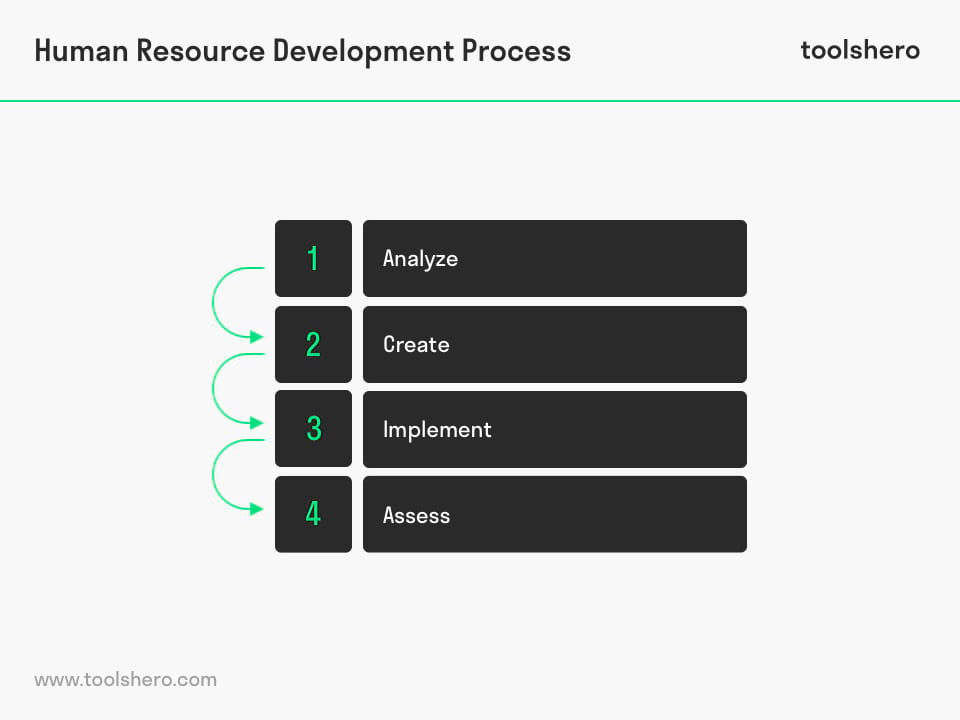Human Resource Development (HRD)

Human Resource Development (HRD): this article explains Human Resource Development (HRD) in a practical way. Next to what it is, this article highlights also the process and the benefits. After reading you will understand this important human resources tool. Enjoy reading!
What is Human Resource Development?
Human Resource Development (HRD) is a part of Human Resource Management that is concerned with the training and development of employees at work.
It is sometimes referred to as a framework that is used for helping employees enhance their knowledge and skills in order to improve organizational productivity, performance, and profitability. The primary underlying thought is that effective HRD leads to employee and customer satisfaction.
The market place has become competitive so it is crucial for today’s organizations to identify potential future job openings that attract the best workers in order to remain competitive. For this reason, Human Resource Development attempt to get the best out of employees by offering opportunities to learn new skills or improve current ones.
It is therefore concerned with employee growth-related activities like external and internal training, including the pace of the training and career development.
HRD is responsible for making sure that employees possess the knowledge, skills, and attitudes that support the position efficiently and effectively.
Importance
The increasingly competitive business environment has caused organizations to take the lead in creating competitive advantages, both internally as externally. Internally, companies and especially the HR department attempt to integrate HRD so that employees remain skilled for the working environment.
Another objective of HRD is to improve the skills of individual workers but also enhance the capabilities of the whole team and the organizations.
We can consequently conclude that HRD focusses on training and development, career development, and organization development on all levels of the organization and organizational effectiveness.
The Human Resource Development Process
- Analyze
- Create
- Implement
- Assess

Figure 1 – The Human Resource Development process
1. Analyze
HRD needs continually assessment of the gap between the capabilities of the employee and what this employee is required to do for the firm (individual and organizational).
It is essential in this step to identify who in the organization needs training and development. To effectively asses HRD it is essential to determine the performance requirement of the organization but also identify what can be improved by training.
The first step in the Human Resource Development process is for this reason concerned with the organizational analysis, task analysis, and person analysis (including the analysis of job satisfaction).
Organizational analysis
Training can only be given when the organization knows how the desired organizational outcomes must look. HRD must for this reason evaluate organizational needs.
This includes the current and future required employee knowledge, skills, and attitudes (KSA). It is important for HRD to additionally analyze the forces that can potentially influence the training of employees.
It means that HRD must be proactive in maintaining the KSA’s but also preventing that the KSA’s of employees will become outdated.
Task Analysis
The Task Analysis deals with the employee skill required to perform a job. For HRD to make a practical task analysis, HRD has to understand the work environment as well as the employees in the work environment to identify shortcomings. In this stage, working conditions are analyzed and include analyzing the environment in which jobs have to perform.
Person analysis
The last step of the analyzation process is to identify who in the organization need training.
In this step, HRD looks at the current and expected performance of individual workers, but it also assesses if employees have the right mix of characteristics that demonstrate that they are ready for training and development.
This could include personal characteristics such as beliefs and motivation.
2. Create
This deals with the design of the HRD program. It includes but is not limited to setting objectives of the learning outcomes, creating lesson plans, assigning leaders who will carry out the program, and making schedules.
In this phase, Human Resource Development designs the training setting, such as assigning the learning location, determining how knowledge and skills have to be acquired, and which materials could be used to reach the development goals.
3. Implement
The third phase of the HRD process deals with the practical training of employees.
The goal of HRD is to find the most efficient and effective way to execute the training. Usually, training is provided in two general ways: on the job training and off the job training.
On the job training
As the name implies, on the job training is related to anything that can be learned in the workplace. From a Human Resource Development perspective, this type of training is concerned with skills and task-related knowledge.
New capabilities can, for example, be acquired by instructions from supervisors or performing new jobs within the organization.
Off the job training
Off the job training is referred to as training that takes place at any other place than the workplace. Training and development can be achieved by attending seminars, performing business simulation games, but also following online courses.
4. Assess
The last step of the HRD process is used to evaluate if the goals are achieved. Have the selected employees for training and development benefit from the program?
Is the gap between the previous performance and desired one filled? These are examples of question HRD must ask in the last phase of the process.
The importance of evaluating the outcome of the initiatives is because it demonstrates what type of programs are appropriate for learning purposes. It additionally identifies the strengths and weaknesses, and it helps managers making future decisions.
Benefits of Human Resource Development
When HRD is integrated effectively in leads to higher productivity of the firm. Since a continual analysis of improvements by the HR department is being made, it leads to better working conditions, which next leads to more employee engagement.
Employees will become loyal because they feel valued, and thus, employee retention will be improved. More satisfaction will be created at work, and as a result of more satisfied employees, there is a high likelihood that the customer service of the company will be improved.
Now it’s your turn
What do you think? Do you recognize the explanation of Human Resource Development? Did you experience any of the benefits as a result of HRD? Do you have any tips or additions you would like to share?
Share your experience and knowledge in the comments box below.
More information
- Garrick, J. (2012). Informal learning in the workplace: Unmasking HRD. Routledge.
- Hill, R., & Stewart, J. (2000). HRD in small organizations. Journal of european industrial training, 24(2/3/4), 105-117.
- Mankin, D., & Mankin, D. (2009). Human resource development. Oxford: Oxford university press.
- McLean, L. D. (2005). Organizational culture’s influence on creativity and innovation: A review of the literature and implications for HRD. Advances in developing human resources,7(2), 226-246.
- Swanson, R. A. (1997). HRD research handbook: Linking research and practice. Berrett-Koehler Publishers.
- Swanson, R. A. (2001). HRD and its underlying theory. Human Resource Development International, 4(3), 299-312.
- Weinberger∗, L. A. (1998). Commonly held theories of HRD. Human Resource Development International, 1(1), 75-93.
How to cite this article:
Zeeman, A. (2019). Human Resource Development (HRD). Retrieved [insert date] from toolshero: https://www.toolshero.com/human-resources/human-resource-development-hrd/
Original publication date: 11/28/2019 | Last update: 07/27/2023
Add a link to this page on your website:
<a href=”https://www.toolshero.com/human-resources/human-resource-development-hrd”>Toolshero: Human Resource Development (HRD)</a>












